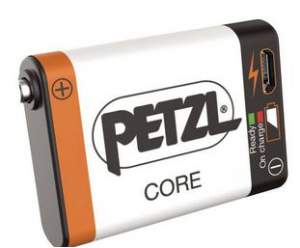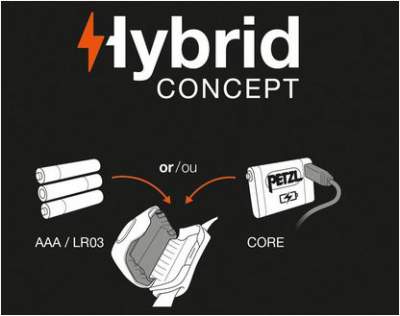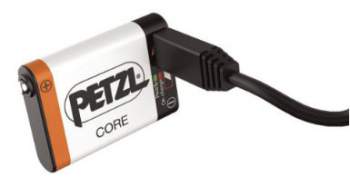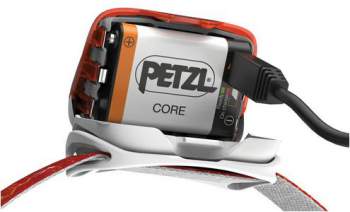Recently, Petzl has launched what they call the CORE battery for their hybrid headlamps. So what is Petzl CORE battery? You will find the answers here.

 Benefits
Benefits
- Versatile, suitable for many Petzl headlamps.
- Very economical solution.
- Easy to use and to charge.
- Lightweight.
CORE – Rechargeable battery compatible with Petzl HYBRID headlamps
This battery should not be mixed with the Accu Core rechargeable battery that was popular some six or seven years ago. This CORE is a completely new product.
What are Hybrid headlamps
In the title you see the term Hybrid, so a few words about this first. Those are Petzl lamps that work on both classic AAA type batteries and on the CORE battery. These are the following headlamps from several Petzl’s groups:
- Classic Series:
– Tikkina.
– Tikka.
– Zipka. - Active Series:
– Actik.
– Actik CORE. - Specialized Headlamp Series:
– Tactikka.
– Tactikka+.
– Tactikka+ RGB.
So the CORE works with all those headlamps, more versatile it can hardly be.

What is the CORE and how it works
This is a high-capacity Lithium-Ion 1250 mAh rechargeable battery. For climbers and mountaineers, it is good to know that it is designed to work even at low temperatures, and it recharges directly through the integrated USB port, no adapter is needed for this. Note that it comes with a micro USB charging cable. Using it instead of AAA batteries makes your headlamp some 10 grams lighter.
The CORE is perfect for frequent use, and according to specifications, it is equivalent to 900 AAA batteries. This is equivalent to a trash bin full of AAA batteries, literally, with all nasty chemicals they contain. Quite impressive for such a small tool.
If you assume that good batteries are around $0.3 – $0.5 per piece, you would spend $300 -$450 for these 900 batteries. Note that the CORE is $30. So these are great economical as well as ecological reasons for using such a rechargeable battery.
There is a charging indicator on the body of the CORE, the red indicates charging and green means it is fully charged. As you see in the picture, you can charge the CORE even without taking it out from the housing.
When not used, it is recommended to store the CORE in a dry and ventilated area. But charge it before extended storage, and recharge it after the storage.
The optimal work temperatures for the Core are in the range from 0°C to +45°C (or from +22°F to +113°F). However, the battery is able to operate in a much broader range from -30°C to +60°C (or from -22°F to +140°F).
The burn time
This is depicted in the picture:

You can compare this with the data for Tikkina headlamp when it is used with three AAA batteries:
- Max autonomy: 220 h.
- Standard: 60 h.
- Max power: 60 h.
Obviously, the classic batteries provide far more burn time. The lamp’s lighting performance changes when you switch from standard to rechargeable batteries and the difference is in lighting stability. Basically, the power changes by following different curves.
The initial power with standard AAA batteries is stronger, but it decreases faster in time. So some 30 minutes later, the power of standard batteries will drop below the power of a rechargeable battery. But later, the power of the CORE drops below the power of the classic batteries. You could visualize this as an exponential and linear decrease for the classic battery and the CORE, respectively.
You could visualize this as an exponential and linear decrease for the classic battery and the CORE, respectively, so that the two curves cross each other twice.
In this video, you can see how the CORE is used with one of the headlamps mentioned above.
Specifications
- Weight: 23 g (0.8 oz).
- Type: rechargeable Lithium-Ion 1250 mAh.
- Recharge time: 3 h.
- Guarantee: one year or 300 charging cycles.
- Charging via the USB port.
- Charging indicators.
- Charging cable included.
Summary & rating
So to conclude this text, I hope that now you have a more clear picture of what Petzl CORE battery is. It is perfect for frequent use, at home or wherever you have the possibility for recharging. This can be the standard wall power, or solar power if you are on the trail. Also, did you know that now there are even wood-burning backpacking stoves with an energy transforming mechanism so that you can charge such batteries while cooking on the trail?
In view of its relatively short burn time, on the trail, it is best to combine the CORE with a set of classic batteries. Clearly, the CORE is a great tool, so many of Petzl headlamps are designed to work with it, and their number is growing. You can see one of them, the recent model Tikkina 150 presented in the site.
Note, in general, Li-Ion rechargeable batteries lose their capacity in time. But after 300 charge/discharge cycles, the CORE still has about 70% of its initial capacity. Please see how I rate this product:
Thank you for reading. I love to hear from you so let me know if you have a question or comment, there is a comment box below. I wish you a pleasant day.



Ronni Raz says
Can I use the core battery with my black diamond spot ? Will it work?
Thanks
Ronni
Jovo says
Hi Rooni, I do not think so. It works with a number of lamps of the Petzl brand.
joel l watson says
Is it possible to damage the battery by leaving it charging too long? I work nights and will be plugging it in and forgetting about it for at least five or six hours while charging.
Jovo says
There should be no problem at all.
Wave says
How water proof is this battery? In the picture it looks like is has many ingress holes rendering the battery less suitable for inclimate weather and would negate the IP4 rating of the headlamps. Thanks.
Jovo says
As far as I know, Petzl gives a waterproof rating for their lamps, and this battery is protected inside a lamp. I do not remember seeing such a rating for the battery.
Matt Williams says
Do you have any comparisons of using the Core pack vs standard batteries in cold weather? I heard that Li-Ion has better battery depletion than standard batteries in cold weather.
Also, sorry, do you know how this would compare against NiMH rechargeable batteries? I (think) I find that these tend to fade far quicker than standard batteries.
Thanks for any help you can give me.
Jovo says
Hi Matt
this what you ask is an important issue. When I climbed Weissmies I had such an experience, not life-threatening just unpleasant, I realized my camera did not work. I was able to make only two photos on the summit although the standard batteries I used were new. You are probably right about better performance of Li-Ion batteries. Petzl also claims that rechargeable batteries perform better in a cold environment, this holds in particular for the Li-Ion type.
I am not so much familiar with NiMH rechargeable batteries but from what I know one of the issues with them is what is described as the memory effect or loss of capacity when they are repeatedly partially charged. I have also seen claims that at low temperatures they have a lower performance than Li-Ion. So probably Li-Ion should be a better option in such conditions. Lithium-ion also recharge quicker.
Dolmen Dweller says
Useful review.
But Petzl are a bit limited, perhaps with good reason, but I am put-off buying.
1250 mAh @ what, 3.7v?
How come other batteries are more capacity (mAh) for the same size/package? Petzl have to fit charging circuitry into the battery. Which I guess gives them an excuse to charge more (no pun intended) for the battery, yet keep the cost of the torch itself down? Why not fit the charge circuitry into the torch (generally weighs somewhat less than the Li-Po battery does, per cubic mm and torch would not be overly-bulky in any case). Then the battery itself – whose size is fixed by the size of three AAA batteries – can be ALL battery, which would make it, what 500mah more at least? 1250mah is poor. My bicycle light is 6000mAh… My smallest battery pack is 3000Mah. Or is that 5000Mah? I forget! The light could also double as a power pack via three AAA batteries, oh no it couldn’t, because that’s 4.5v, under 5V USB standard. So a better design would be FOUR AAA batteries (I’d say AA ones but that’s an over-sized, unnecessary luxury not a sticking-point of design). Then you get 6V, and can regulate it to 5V via the aforementioned charging circuitry. Then one can ignore that facility – except for the emergency where one has spare AAA batteries and no USB charge left in one’s (smart)phone and needs to call for rescue…
I imagine someone at Petzl had the same concepts come to them, and maybe put them in another model, but I personally like to buy once, buy durable and flexible (within reason, these are often conflicting properties in a piece of kit). 10grams lighter? Seriously, just use more damned muscle power, even climbing, 10g is nothing. Even if it’s replicated over ten items of kit; e.g. 100g is nothing. Some design compromises are a bit orthodoxy-pathological, with all due respect to those who need lightweight kit. Oh yeah and the casing on my ‘lightweight’ older model Petzl headtorch is cracked. So lightweight definitely has multiple limitations in usefulness.
Jovo says
Hi Dolmen, thank you for the thoughts you gave here and the issues you raised. I would agree with most of it. I guess those questions are for the Petzl designers. Can tell you my own experience/practice, I always have two different sets of batteries, one in the torch and one in the pocket. I do not really care about extra grams, want to be ready if the problem appears. As we say in my native language ‘the devil never sleeps’. So it is easy to agree about the emergency purpose you mentioned. As for the craked torch, this is clearly another issue, I have also had some problems with one of my previous headlamps from this brand, but this does not mean that Petzl makes unreliable equipment. Any torch can crack.